Art & Architecture
 |
 |
 |
 |
 |
 |
 |
A Diamond Won by the Law of Hospitality
Recently I came across an article written by Prince Michael of Greece, historian and story-teller, describing an interesting episode in the history of the famous Koh-I-Noor, one of the world largest cut diamonds. Whole books have been written on this better-described as "infamous" jewel, for the coveted diamond is believed to carry a curse for men who own it, but, oddly enough, not for women.
 After long and winding travels, it was set in the crown of Queen Victoria, and made its last public appearance resting atop her coffin for her funeral in 2002. Otherwise, the 105-carat gemstone forms part of the Crown Jewels display at the Tower of London. It is in the news today because India is demanding its return, claiming it was "stolen" from them by the English. It is unlikely that will happen.
After long and winding travels, it was set in the crown of Queen Victoria, and made its last public appearance resting atop her coffin for her funeral in 2002. Otherwise, the 105-carat gemstone forms part of the Crown Jewels display at the Tower of London. It is in the news today because India is demanding its return, claiming it was "stolen" from them by the English. It is unlikely that will happen.
But, back to our story, which lies in its more ancient history, when it belonged to the Great Mughals of the Mughal Emprie, mainly corresponding to the mdodern countries of India, Pakistan, Afghanistan and Bangladesh.
At the beginning of the 18th century, the huge diamond was part of the immense treasures of the Mughal of the time, Emperor Mohammed Shah Rangila. According to the popular legend, this Emperor was forced to give it to the conniving Persian ruler Nader Shah rather than breach the law of hospitality at a ceremonial turban swap.
The legend is disputed today by some modern historians, but not Prince Michael. Regardless, the story reveals the solemn role of ceremony and observing the laws of hospitality in the long-lost and longed-for ceremonial past.
A difficult dilemma
The mid-18th century saw a much weakened Empire of India, a fact of which the Persian ruler Nadir Shah, or “the Slave to the Wonderful” as he was called, was ready to take advantage. He invaded India and, at the decisive battle of Karnal in 1738, he soundly defeated the vast Indian army. More than 20,000 of the Great Mughal's troops were slain on the battlefield, a greater number taken prisoner, and all his immense treasures seized.
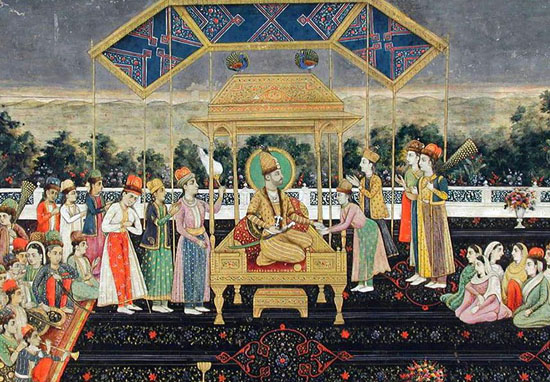 Among those riches was the marvelous Peacock Throne, its cushions and canopy embroidered with pearls and diamonds the gold peacock atop it consisted all of sapphires, rubies and other precious jewels. Then, when the Emperor seated himself on the throne, the great diamond Koh-I-Noor, set as a pendant, was hung from the canopy to be always before his eyes.
Among those riches was the marvelous Peacock Throne, its cushions and canopy embroidered with pearls and diamonds the gold peacock atop it consisted all of sapphires, rubies and other precious jewels. Then, when the Emperor seated himself on the throne, the great diamond Koh-I-Noor, set as a pendant, was hung from the canopy to be always before his eyes.
However, the famed Koh-I-Noor was missing from the Peacock Throne, and Nadir Shah desired this diamond at all costs and set himself to the task of discovering the gem. One woman of the Emperor's harem, taken by Nadir Shah in the spoils, told him that the Great Mughal always kept it hidden in his turban. So, the shrewd Nadir Shah invited the Great Mughal to a grand feast to be celebrated as a gesture of peace and reconciliation
At the end of dinner, as a token of friendship, Nadir Shah suddenly proposed an exchange of turbans, which is a well-known oriental custom signifying the creation of brotherly ties, sincerity and eternal friendship.
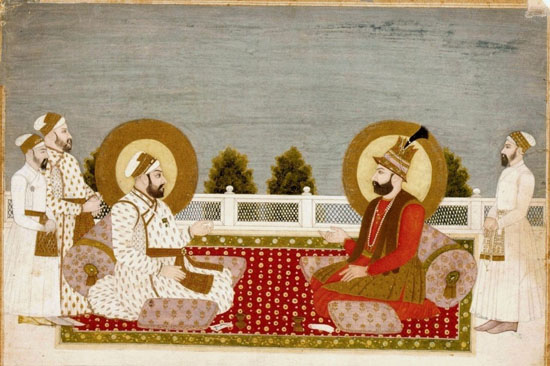
Mohammed Shah understood immediately that the Koh-I-Noor was lost to him, but he was hardly in a position to resist such a request. With as much grace as he could summon – in fact his composure was such that Nadir Shah thought he had been hoaxed – he accepted, exchanging his treasure for Nadir Shah's worthless turban.
Returning to his private chambers, Nadir Shah unfolded the turban and fumbled feverishly in the material; suddenly he saw the diamond concealed within. When he set his eyes on its dazzling beauty, he exclaimed aloud "Koh-I-Noor!" which means "Mountain of Light." The most famous diamond in history now had a name that it retains to this day.
It is interesting to see how seriously protocol was taken in the Eastern world. It was nigh impossible for Mohammed Shah to refuse to make the exchange of turbans without rupturing the friendship and peace that had just been established. And so an invaluable diamond was diffidently handed over to a new owner because he could not breach protocol.
Epilogue
Nadir Shah returned to Persia at the head of a caravan of 7,000 camels, but he only lived a few years before he was assassinated in his tent in 1756. His treasures were looted and the Koh-I-Noor was lost to History for some years.
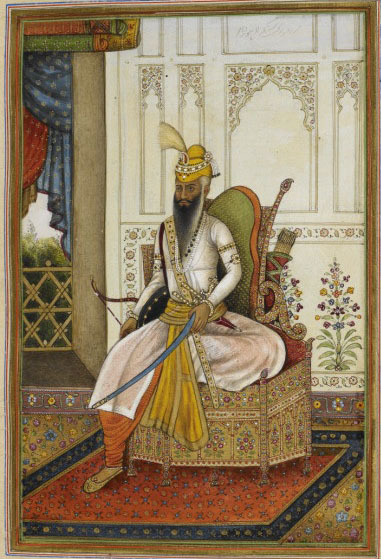 Nadir Shah's grandson sent mercenaries all over Persia to recover the precious diamond and at last it was found with a Mullah using it as a paperweight. It passed to Shah Shuja Durani, who was overthrown. To win his freedom, he gave the Koh-I-Noor to Maharaja Ranjit Singh, who had stepped in to save his life.
Nadir Shah's grandson sent mercenaries all over Persia to recover the precious diamond and at last it was found with a Mullah using it as a paperweight. It passed to Shah Shuja Durani, who was overthrown. To win his freedom, he gave the Koh-I-Noor to Maharaja Ranjit Singh, who had stepped in to save his life.
The curse on men who owned the Koh-I-Noor made itself felt again. Shortly after he received the grandiose gift, he suffered two strokes. The immediate two successors of Ranjith Singh died in strange circumstances, and finally his youngest son, also Ranjith Singh, took the throne and the Koh-I-Noor.
The Sikh Kingdom entered into war with England and suffered a resounding defeat. The last Maharajah Rajith Singth was forced to cede his throne to the British Crown and the Koh-I-Noor to the East India Company, who gifted it to Queen Victoria.
At this point the bad luck ended for the owner, although the grand diamond suffered a bit in this transfer. The Queen found that the stone did not shine enough cut the old fashioned way. She had it re-cut in London and the 180-carat Koh-I-Noor became 108 carats. But there was a recompense for its loss in size: It now had the fame of being the most sparkling diamond in the world.
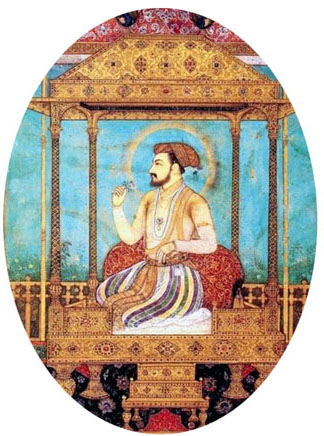


Above, the Koh-I-Noor; below, it was set in the Crown used for the Queen's coronation
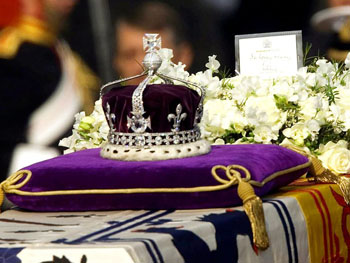
But, back to our story, which lies in its more ancient history, when it belonged to the Great Mughals of the Mughal Emprie, mainly corresponding to the mdodern countries of India, Pakistan, Afghanistan and Bangladesh.
At the beginning of the 18th century, the huge diamond was part of the immense treasures of the Mughal of the time, Emperor Mohammed Shah Rangila. According to the popular legend, this Emperor was forced to give it to the conniving Persian ruler Nader Shah rather than breach the law of hospitality at a ceremonial turban swap.
The legend is disputed today by some modern historians, but not Prince Michael. Regardless, the story reveals the solemn role of ceremony and observing the laws of hospitality in the long-lost and longed-for ceremonial past.
A difficult dilemma
The mid-18th century saw a much weakened Empire of India, a fact of which the Persian ruler Nadir Shah, or “the Slave to the Wonderful” as he was called, was ready to take advantage. He invaded India and, at the decisive battle of Karnal in 1738, he soundly defeated the vast Indian army. More than 20,000 of the Great Mughal's troops were slain on the battlefield, a greater number taken prisoner, and all his immense treasures seized.

Mughal Emperor Mohammed Shah Rangila on his marvelous Peacock Throne
However, the famed Koh-I-Noor was missing from the Peacock Throne, and Nadir Shah desired this diamond at all costs and set himself to the task of discovering the gem. One woman of the Emperor's harem, taken by Nadir Shah in the spoils, told him that the Great Mughal always kept it hidden in his turban. So, the shrewd Nadir Shah invited the Great Mughal to a grand feast to be celebrated as a gesture of peace and reconciliation
At the end of dinner, as a token of friendship, Nadir Shah suddenly proposed an exchange of turbans, which is a well-known oriental custom signifying the creation of brotherly ties, sincerity and eternal friendship.

An exchange of turbans is proposed by the crafty Nadir Shah, left
Mohammed Shah understood immediately that the Koh-I-Noor was lost to him, but he was hardly in a position to resist such a request. With as much grace as he could summon – in fact his composure was such that Nadir Shah thought he had been hoaxed – he accepted, exchanging his treasure for Nadir Shah's worthless turban.
Returning to his private chambers, Nadir Shah unfolded the turban and fumbled feverishly in the material; suddenly he saw the diamond concealed within. When he set his eyes on its dazzling beauty, he exclaimed aloud "Koh-I-Noor!" which means "Mountain of Light." The most famous diamond in history now had a name that it retains to this day.
It is interesting to see how seriously protocol was taken in the Eastern world. It was nigh impossible for Mohammed Shah to refuse to make the exchange of turbans without rupturing the friendship and peace that had just been established. And so an invaluable diamond was diffidently handed over to a new owner because he could not breach protocol.
Epilogue
Nadir Shah returned to Persia at the head of a caravan of 7,000 camels, but he only lived a few years before he was assassinated in his tent in 1756. His treasures were looted and the Koh-I-Noor was lost to History for some years.

Maharajah Ranjit Singh became the owner of the diamond, but soon met a sad fate
The curse on men who owned the Koh-I-Noor made itself felt again. Shortly after he received the grandiose gift, he suffered two strokes. The immediate two successors of Ranjith Singh died in strange circumstances, and finally his youngest son, also Ranjith Singh, took the throne and the Koh-I-Noor.
The Sikh Kingdom entered into war with England and suffered a resounding defeat. The last Maharajah Rajith Singth was forced to cede his throne to the British Crown and the Koh-I-Noor to the East India Company, who gifted it to Queen Victoria.
At this point the bad luck ended for the owner, although the grand diamond suffered a bit in this transfer. The Queen found that the stone did not shine enough cut the old fashioned way. She had it re-cut in London and the 180-carat Koh-I-Noor became 108 carats. But there was a recompense for its loss in size: It now had the fame of being the most sparkling diamond in the world.


Posted October 16, 2019
______________________
______________________
 Volume I |
 Volume II |
 Volume III |
 Volume IV |
 Volume V |
 Volume VI |
 Volume VII |
 Volume VIII |
 Volume IX |
 Volume XI |
 Special Edition |
 Special Edition |


